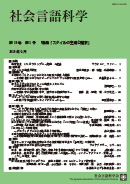Volume 17, Issue 1
Displaying 1-14 of 14 articles from this issue
- |<
- <
- 1
- >
- >|
-
Article type: Article
2014Volume 17Issue 1 Pages 1-3
Published: September 30, 2014
Released on J-STAGE: May 03, 2017
Download PDF (426K) -
Article type: Article
2014Volume 17Issue 1 Pages 4-19
Published: September 30, 2014
Released on J-STAGE: May 03, 2017
Download PDF (2158K) -
Article type: Article
2014Volume 17Issue 1 Pages 20-35
Published: September 30, 2014
Released on J-STAGE: May 03, 2017
Download PDF (1782K) -
Article type: Article
2014Volume 17Issue 1 Pages 36-48
Published: September 30, 2014
Released on J-STAGE: May 03, 2017
Download PDF (1815K) -
Article type: Article
2014Volume 17Issue 1 Pages 49-60
Published: September 30, 2014
Released on J-STAGE: May 03, 2017
Download PDF (1463K) -
Article type: Article
2014Volume 17Issue 1 Pages 61-76
Published: September 30, 2014
Released on J-STAGE: May 03, 2017
Download PDF (1985K) -
Article type: Article
2014Volume 17Issue 1 Pages 77-84
Published: September 30, 2014
Released on J-STAGE: May 03, 2017
Download PDF (1045K) -
Article type: Article
2014Volume 17Issue 1 Pages 85-97
Published: September 30, 2014
Released on J-STAGE: May 03, 2017
Download PDF (1982K) -
Article type: Article
2014Volume 17Issue 1 Pages 98-113
Published: September 30, 2014
Released on J-STAGE: May 03, 2017
Download PDF (1580K) -
Article type: Article
2014Volume 17Issue 1 Pages 114-127
Published: September 30, 2014
Released on J-STAGE: May 03, 2017
Download PDF (1446K) -
Article type: Article
2014Volume 17Issue 1 Pages 128-130
Published: September 30, 2014
Released on J-STAGE: May 03, 2017
Download PDF (388K) -
Article type: Article
2014Volume 17Issue 1 Pages 131-133
Published: September 30, 2014
Released on J-STAGE: May 03, 2017
Download PDF (348K) -
Article type: Article
2014Volume 17Issue 1 Pages 134-141
Published: September 30, 2014
Released on J-STAGE: May 03, 2017
Download PDF (946K) -
Article type: Article
2014Volume 17Issue 1 Pages 142-148
Published: September 30, 2014
Released on J-STAGE: May 03, 2017
Download PDF (752K)
- |<
- <
- 1
- >
- >|
